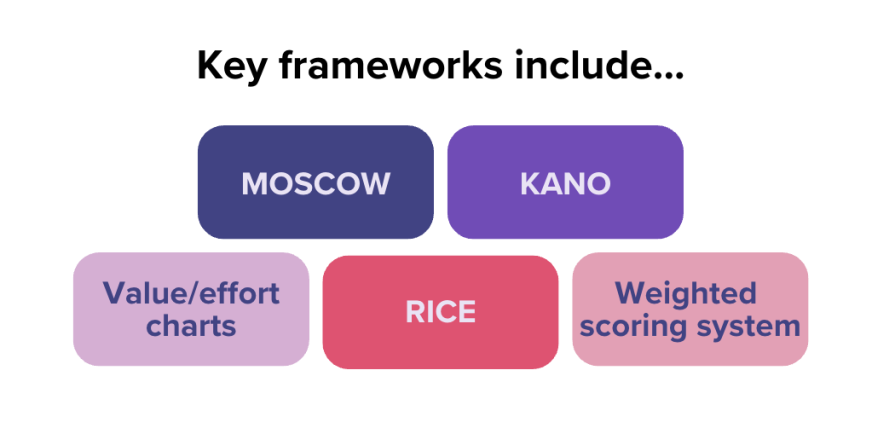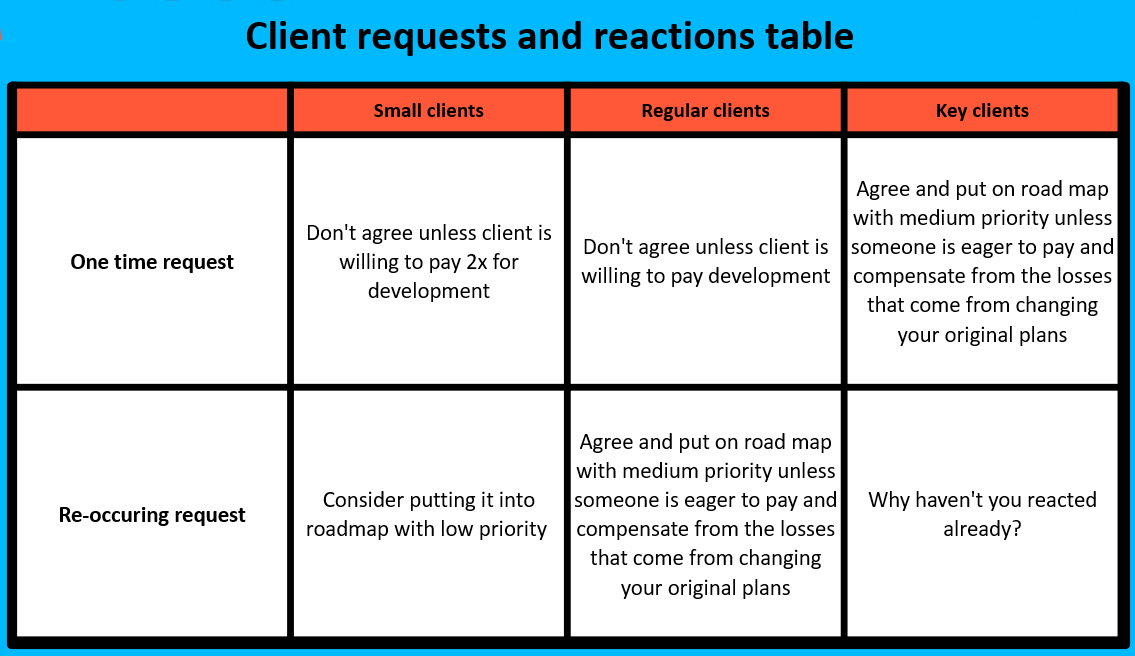Prioritization is both an art and a science and a crucial element of any product manager’s day-to-day duties. Typical companies expect prioritization to take into account business goals, complexity, impact, and the certainty that a specific update delivers on its promises. However, in the world of endless possibilities (and product copycats), more and more customer-centricity (and even obsession) has become a reliable way to win the market and remain the top player in one’s market.

Because of this, the prioritization question has shifted from, “How can we profit more off our clients,” towards, “How can we better serve our clients” and hope, with high certainty, that money will follow suit.
Customer-valued prioritization focuses on placing user impact at the forefront of your product decisions while maintaining alignment with broader organizational objectives. But even this seemingly focused prioritization method isn’t really straightforward. You often have to juggle diverse customer feedback, conflicting priorities, and the challenge of staying true to the product vision.
To ease this challenge, this blog post explores practical frameworks, strategies for managing client size considerations, and actionable steps to implement customer-valued prioritization effectively.
Customer-valued prioritization methods aim to prioritize features and updates that deliver the most value to end users while ensuring these choices align with business objectives as much as possible. Unlike generic prioritization methods, customer-valued approaches place user and/or client impact at the heart of decision-making.
A few examples include:
This distinction is critical for building user-centered products. Typical prioritization frameworks focus on factors like effort and return on investment. However, what you want to focus on in a customer-centered world is the voice of the customer and evaluate how a feature or improvement addresses their pain points or enhances their experience.
Sounds easier than putting business first? Well, not quite.
Whether it’s about bringing more business in directly or creating a product that’s hard to resist, the prioritization process will never be simple. There are two main reasons for that:
Let’s not dive into this right now (it’s a story for another article), I just wanted to acknowledge the fundamental challenges when it comes to having a clear and reliable prioritization process.
The unique challenges that emerge when dealing with customer needs are:
It’s not a surprise that your users don’t usually know your product vision and strategy. They build their requests based on their needs and how they envision using your product. While it ties in with the next point, it’s clear that you’re dealing with users that have niche needs and you need to stick to the fundamentals of your vision/strategy.
On the other hand, if a significant portion of your users unknowingly question your direction, perhaps your direction is wrong and it’s time to reevaluate it.
With B2B products, large enterprise clients may demand attention due to their revenue contribution. This means that while often valid and important, the small clients’ voices might be ignored. Now, while you may see more value and “fun” in requests coming from the little guys, it’s wiser to focus on those companies who pay your bills and bonuses.
There are two other ways to approach it: Either grow the team to accommodate more work and thus build something that’s not only focused on big enterprise clients, or add “cost of opportunity lost” to your prioritization vectors. While optimizing for the biggest clients, you may end up not innovating enough and allowing your competitors to grow. In that case, you’ll eventually lose those big clients eventually and it’ll be just a matter of time.
I like to call this one “not listening to the loudest guy in the room” issue. Sometimes drastic and angry pieces of feedback may appear to be the end of the world, but the truth is it’s just one voice. It shouldn’t determine your next steps in a product used by thousands if not millions of users.
The key is to extract actual feedback trends that’ll benefit most of your users and include them in your prioritization process. This can either be done manually or using modern AI solutions.
In an ideal world, you can take a pool of tasks and decide their order based on several parameters. But what if you face an impossible situation where two requests would have to be completed by the same deadline and you can only do one? Or does completing one basically make the other one obsolete? In such cases, you simply need data and answer the following (and more) questions:
In the end, a decision has to be made. Making it an educated and data-driven one will help calm down the stakeholder whose requests were turned down.
While prioritization frameworks aren’t usually designed specifically for user-centered approaches, several of them can be easily adapted to that concept:

MOSCOW stands for must-have, should-have, could-have, and would-like-to-have. This framework allows you to prioritize features based on their necessity and level of importance:
Use customer feedback to define what qualifies as a “must-have” versus a “should-have.” For example, if multiple clients request a critical improvement to their workflow, elevate it to a must-have.
This is a framework for determining customer satisfaction with a product or service. It helps product managers to prioritize features based on their level of customer satisfaction and importance.
This framework is already fully adapted to customer-value prioritization.
My framework of choice. This is a prioritization framework where you prioritize features based on their potential value and the effort required to implement them. It uses a 2-dimensional matrix to plot features on a grid.
Narrow down the “value” to basically only contain “customer value” with a smaller emphasis on business and prioritization vectors that would impact the final order in the backlog.
Here, one is prioritizing features based on their reach, impact, confidence, and effort. It helps you to prioritize features based on their potential reach and impact, as well as the level of confidence and effort required to implement them:
When applying RICE, weigh reach and impact more heavily for user feedback themes. For example, prioritize a feature impacting 80 percent of your customers, even if it requires more effort than a feature affecting a smaller subset:
In this framework, each feature is evaluated against a set of criteria, such as customer value, feasibility, and alignment with the company’s goals, and is assigned a score. The scores are then multiplied by the weight of each criterion to determine the overall priority of the feature. The features with the highest scores are considered to be the most important and should be prioritized:
Similar to RICE, weigh customer-related aspects of the equation the highest. Unlike the value/effort application proposition, here you can still include all other vectors, but give them relatively small weights.
The table below explains how to handle client requests for product development or changes based on their size and the type of request. So, to put it in plain English:

In order to build products that users will enjoy you need to put them in front of your prioritization process. Very often product organizations claim to be user-centric while in fact it’s the business side that dominates. Using a prioritization model that is client-valued is the first step to making this almost universal claim a reality.
Of course, this won’t matter without user-centered goals and strategy, but achieving those is a story for another time. In the meantime, thank you for exploring this piece and hope to see you in my next blog post!
Featured image source: IconScout

LogRocket identifies friction points in the user experience so you can make informed decisions about product and design changes that must happen to hit your goals.
With LogRocket, you can understand the scope of the issues affecting your product and prioritize the changes that need to be made. LogRocket simplifies workflows by allowing Engineering, Product, UX, and Design teams to work from the same data as you, eliminating any confusion about what needs to be done.
Get your teams on the same page — try LogRocket today.

Learn why slide decks slow teams down and explore better tools like whiteboards, PRDs, and prototypes to improve collaboration and alignment.

AI PM roles are evolving fast. Learn the five types of AI PMs, the skills they need, and how they shape AI products across industries.

Learn how you can use AI agents to automate workflows, boost productivity, and choose the right tools while avoiding common pitfalls.

Move fast, but not recklessly. Learn how to run ethical product experiments that protect users, build trust, and maintain speed.